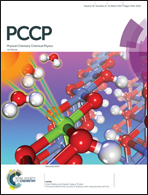Molecular and dissociative adsorption of water and hydrogen sulfide at perfect and defective Cu(110) surfaces†
Abstract
We performed a density functional theory (DFT) investigation of the molecular and dissociative adsorption of H2O and H2S at perfect and defective Cu(110) surfaces described using supercells with c(6 × 6) periodicity. The defective surface consists of a terrace surrounded by pits. We found considerable differences in adsorption modes and energies for H2O and H2S. At the defective Cu(110) surface, monomers of H2O and H2S preferentially adsorb at the terrace site and molecular adsorption of H2O is significantly more favorable than that of H2S. For dissociative adsorption however, the sulfur species are considerably more stable than the oxygen species. For monolayer (ML) coverages, there are small differences in the molecular adsorption energies for H2O and H2S. However, for the formation of 1 ML of HO and 1 ML of HS from 1 ML of H2O and 1 ML of H2S, respectively, with the release of H2(g), the differences are very large. The formation of 1 ML HO at the perfect Cu(110) surface is endoergic, while at the defective Cu(110) surface it is exoergic by −0.6 eV. For high coverages, H2S forms stacked half-monolayers that interact with each other via a complex hydrogen bond network with a strength per H2S molecule of −0.140 eV per H2S and −0.120 eV per H2S for H2S located in the underlayer and overlayer, respectively. The large distances between hydrogen bonded H2S molecules explain the preference for the formation of the two stacked half-monolayers of H2S instead of a single monolayer as it happens with H2O. Additionally, the formation of 1 ML of HS does not occur because of the spontaneous splitting of some H–S bonds resulting in surface bound HS and S and H2S molecules. Extensive surface reconstruction and relaxation accompanies adsorption of the sulfur adsorbates. Such reconstructions with outwards pull of Cu atoms can be at the origin of the weak adhesion of sulfide films that explains the release of CuS particles from copper sulfide films at copper surfaces. Overall, the surface defects here investigated induce non-linear effects in the molecular and dissociative adsorption energies of different O and S adsorbates.



 Please wait while we load your content...
Please wait while we load your content...